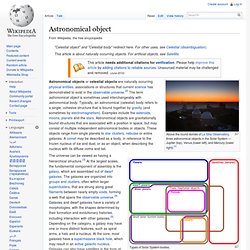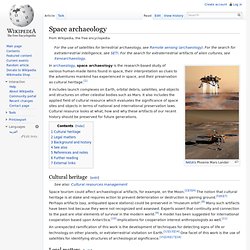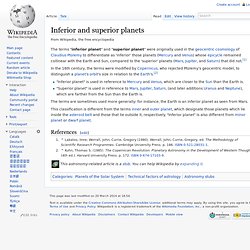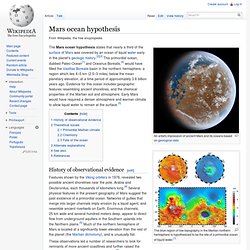

Astronomical object. Above the round domes of La Silla Observatory, three astronomical objects in the Solar System — Jupiter (top), Venus (lower left), and Mercury (lower right).[1] Types of Solar System bodies.

Astronomical objects or celestial objects are naturally occurring physical entities, associations or structures that current science has demonstrated to exist in the observable universe.[2] The term astronomical object is sometimes used interchangeably with astronomical body. Typically, an astronomical (celestial) body refers to a single, cohesive structure that is bound together by gravity (and sometimes by electromagnetism). Examples include the asteroids, moons, planets and the stars. Astrochemistry. Astrochemistry is the study of the abundance and reactions of chemical elements and molecules in the universe, and their interaction with radiation.

Space archaeology. NASA's Phoenix Mars Lander In archaeology, space archaeology is the research-based study of various human-made items found in space, their interpretation as clues to the adventures mankind has experienced in space, and their preservation as cultural heritage.[1] It includes launch complexes on Earth, orbital debris, satellites, and objects and structures on other celestial bodies such as Mars.

It also includes the applied field of cultural resource which evaluates the significance of space sites and objects in terms of national and international preservation laws. Cultural resource looks at what, how and why these artifacts of our recent history should be preserved for future generations. Cultural heritage[edit] Legal matters[edit] The complexities and ambiguities of international legal structures to deal with these sites as cultural resources leave them vulnerable to impacts in the near future by many varieties of space travel. Background and history[edit] Space exploration. Saturn V rocket, used for the American manned lunar landing missions The Moon as seen in a digitally processed image from data collected during a spacecraft flyby While the observation of objects in space, known as astronomy, predates reliable recorded history, it was the development of large and relatively efficient rockets during the early 20th century that allowed physical space exploration to become a reality.
Common rationales for exploring space include advancing scientific research, uniting different nations, ensuring the future survival of humanity and developing military and strategic advantages against other countries. Space colonization. Space colonization (also called space settlement, or extraterrestrial colonization) is permanent human habitation that is not on Earth.

Many arguments have been made for space colonization. The two most common ones are survival of human civilization and the biosphere from possible disasters (natural or man-made), and the huge resources in space for expansion of human society. However right now the challenges, both technological and economic, involved in building a space colony are as great as the potential payoff. Space settlements would have to provide for all the material needs of hundreds or thousands of humans in an environment out in space that is very hostile to human life. They would involve technologies, such as closed-loop life support systems, that have yet to be developed in any meaningful way. There have been no space colonies built so far, nor are there any governments or large-scale private organizations with a timetable for building any. Reasons[edit] J. Goals[edit]
Stellar black hole. A stellar black hole (or stellar mass black hole) is a black hole formed by the gravitational collapse of a massive star.[1] They have masses ranging from about 3 to several tens of solar masses.[2] The process is observed as a hypernova explosion[citation needed] or as a gamma ray burst[citation needed]. These black holes are also referred to as collapsars. Properties[edit] By the no-hair theorem, a black hole can only have three fundamental properties: mass, electric charge and angular momentum (spin). It is believed that black holes formed in nature all have spin, but no definite observation on the spin has been performed. Space exposure. Space exposure is the subjection of a human to the conditions of outer space, without protective clothing and beyond the Earth’s atmosphere in a vacuum.

Explanation and history[edit] For the effect of rapid decompression to vacuum conditions, see the main article at Uncontrolled decompression. Ebullism, hypoxia, hypocapnia and decompression sickness[edit] Few humans have experienced these four conditions. Joseph Kittinger experienced localised ebullism during a 31 kilometres (19 mi) ascent in a helium-driven gondola.[1] His right-hand glove failed to pressurise and his hand expanded to roughly twice its normal volume[6][7] accompanied by disabling pain.
Super-Dense Water. Speculation[edit] Speculation exists that a planet located at around 30 light-years away from Earth may contain super-dense water.

CH star. CH stars are particular type of carbon stars which are characterized by the presence of exceedingly strong CH absorption bands in their spectra.

They belong to the star population II, meaning they're metal poor and generally pretty middle-aged stars, and are underluminous compared to the classical C–N carbon stars. Many CH stars are known to be binaries, and it's reasonable to believe this is the case for all CH stars. Celestial event. Inferior and superior planets. In the 16th century, the terms were modified by Copernicus, who rejected Ptolemy's geocentric model, to distinguish a planet's orbit's size in relation to the Earth's.[2] The terms are sometimes used more generally: for instance, the Earth is an inferior planet as seen from Mars.

This classification is different from the terms inner and outer planet, which designate those planets which lie inside the asteroid belt and those that lie outside it, respectively. "Inferior planet" is also different from minor planet or dwarf planet. Jump up ^ Lakatos, Imre; Worrall, John; Currie, Gregory (1980). Worrall, John; Currie, Gregory, ed. Reusable launch system.
RLV redirects here.

For the World War II German Reichsluftverteidigung (RLV) see Defence of the Reich. A reusable launch system (or reusable launch vehicle, RLV) is a launch system which is capable of launching a launch vehicle into space more than once. This contrasts with expendable launch systems, where each launch vehicle is launched once and then discarded. Mars ocean hypothesis. An artist's impression of ancient Mars and its oceans based on geological data The blue region of low topography in the Martian northern hemisphere is hypothesized to be the site of a primordial ocean of liquid water.[1] History of observational evidence[edit] Features shown by the Viking orbiters in 1976, revealed two possible ancient shorelines near the pole, Arabia and Deuteronilus, each thousands of kilometers long.[6] Several physical features in the present geography of Mars suggest the past existence of a primordial ocean.

Networks of gullies that merge into larger channels imply erosion by a liquid agent, and resemble ancient riverbeds on Earth. Formation and evolution of the Solar System. This widely accepted model, known as the nebular hypothesis, was first developed in the 18th century by Emanuel Swedenborg, Immanuel Kant, and Pierre-Simon Laplace. Its subsequent development has interwoven a variety of scientific disciplines including astronomy, physics, geology, and planetary science. Since the dawn of the space age in the 1950s and the discovery of extrasolar planets in the 1990s, the model has been both challenged and refined to account for new observations. Fuzzball (string theory) Theorized fuzzballs, like classic black holes, distort spacetime and bend light. Here, the edge of the central dark spot, the event horizon, delineates not only the threshold where its escape velocity equals the speed of light but also a fuzzball’s physical surface.
(Artist rendition) Fuzzballs are theorized by some superstring theory scientists to be the true quantum description of black holes. The theory resolves two intractable problems that classic black holes pose for modern physics: H II region. An H II region is a large, low-density cloud of partially ionized gas in which star formation has recently taken place. The short-lived blue stars forged in these regions emit copious amounts of ultraviolet light that ionize the surrounding gas.
H II regions—sometimes several hundred light-years across—are often associated with giant molecular clouds. The first known H II region was the Orion Nebula, which was discovered in 1610 by Nicolas-Claude Fabri de Peiresc. H II regions are named for the large amount of ionised atomic hydrogen they contain, referred to as H II, pronounced H-two by astronomers (an H I region being neutral atomic hydrogen, and H2 being molecular hydrogen).
Cosmic latte. Through the Wormhole. Development[edit] On 17 February 2011, Sean Carroll confirmed on his Twitter page that he has started shooting Season 2 of Through the Wormhole.[3] On 17 May 2011, Discovery confirmed the second season would premiere on Science on 8 June 2011.[4] Astrophysics. Interstellar nitrogen monohydride. Nitrogen monohydride (NH) is a simple compound that has been detected in interstellar space. Black hole. A black hole is defined as a region of spacetime from which gravity prevents anything, including light, from escaping.[1] The theory of general relativity predicts that a sufficiently compact mass will deform spacetime to form a black hole.[2] Around a black hole, there is a mathematically defined surface called an event horizon that marks the point of no return.
Gamma-ray burst. Artist's illustration showing the life of a massive star as nuclear fusion converts lighter elements into heavier ones. List of gravitationally rounded objects of the Solar System. Galactic Center. Superluminal motion. Superluminal motion. Accretion (astrophysics) Artist's impression of a binary system with an accretion disk surrounding a black hole In astrophysics, the term accretion is used for at least two distinct processes. Spiral galaxy. Planets beyond Neptune. White hole. Space roar. Extra-vehicular activity. Tidal acceleration. List of nearest known stars. Solar wind.